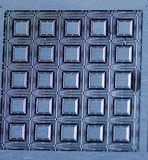What are the most common design problems in Photo Etching?

The biggest design problem is that the design requirements for photo etching are not widely understood. The five most common etching design problems are:
Specifying material thickness in excess of what the application requires. It is not uncommon to see drawings asking for much heavier gauges of metal than the parts function may require. Frequent situations include parts that do not have functional or structural roles being designed with 18 or 20 gauge steel because the designer thought it was common. Heavier gauges are common in sheet metal applications, but are not suited to photo etching. In stainless or carbon steel, 20-gauge (about .036) is the upper limit. In aluminum sheet, the photo etching process can handle up to 12-gauge (.080). In copper sheet, the etching limit would be 14-gauge (.065). Understand that with every mil (.001) of thickness comes another fixed increment of etching time. Use the lightest material suitable for the process.
Although the metal etching process can generally achieve +/-15% of the metal thickness, tighter tolerances affect costs. +/-.0015 is the minimum absolute tolerance and can only be achieved if the metal is .010 thick or less. +/-.005 is suitable for metal thicknesses up to .030. Tolerances for thicker materials will be +/-20% of the metal thickness. The tighter the tolerance band, the smaller the sheet size, and the higher the costs. The economies of photo etching are best realized by being as generous as possible with tolerances. Location tolerances are defined by the CAD data and will consistently be +/-.001 to drawing nominal.
Metal thickness also defines minimum feature sizes in photo etching. The minimum dimension for etching holes is at least 110% of metal thickness. The photo etching process uses etching solution to dissolve the metal to be removed. In order to etch all the way through the metal, there needs to be enough space for the etchant to flow. Similarly, the land area between holes needs to be at least equal to the metal thickness. The reason here is that the etchant will undercut the photo resist and cause the land area to be etched away.
Another problem we encounter with customer designs is lack of attention to industry standards with regard to raw material. Strip metals are generally rolled to a thickness tolerance of +/- 10% of the nominal. Precision stainless strip is available at +/-5% of nominal. Drawing call outs that are tighter than industry norms can lead to a lot of excess cost. Many alloys can be precision rolled to +/-.0001 on thickness, but expect to pay upwards of $1000 per pound and wait 12 weeks for it. There is no industry standard for flatness of rolled metals, even for tension leveled material. This applies to all rolled metals, not just for photo etching.
The overall availability and variety of metals has changed. There are many more alloys covered by standards than are being made. In the past half dozen years alone, the stock situation for raw materials has been significantly rationalized both at the distribution levels and at the mills. The mills will still make whatever you want, but you wont like the cost or the minimum weight. It becomes a major challenge when a legacy part for a prime contractor is calling for what we call un-obtainium. Before specifying an alloy based on its data sheet, contact us to see if its really available.
These are the five most frequent problems we see with new designs being considered for photo etching. One of the reasons were here is to answer those questions before they become specifications.
In shorthand, the five design mistakes to avoid in photo etching are:


